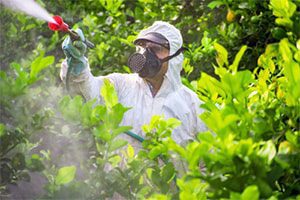
Pesticides Metalaxyl and Lindane Linked to an Increased Risk for Developing Thyroid Cancer USA – A news report posted on the Oncology Learning Network (oncnet.com) states that a recent investigation conducted on “male pesticide applicators” has associated exposure to two pesticides used in combination, lindane and metalaxyl, with a heightened risk for developing thyroid cancer. The study has […]

Metalaxyl and Lindane Thyroid Cancer
USA – A news report posted on the Oncology Learning Network (oncnet.com) states that a recent investigation conducted on “male pesticide applicators” has associated exposure to two pesticides used in combination, lindane and metalaxyl, with a heightened risk for developing thyroid cancer. The study has been published in the Environmental International, Volume 126, January 2021.
According to Catherine C. Lerro, Ph.D., MPH, Division of Cancer Epidemiology and Genetics, National Cancer Institute in Rockville, Maryland, and professional colleagues, There are several pesticides that have been identified to have “thyroid-disrupting properties.” Dr. Lerro also stated that there hadn’t been enough studies to evaluate the causal link between specific pesticide ingredients and an increased risk of thyroid cancer. According to Dr. Lerro, her group investigated “self-reported pesticide use” and incidences of thyroid cancer in the Agricultural Health Study (AHS). The Agricultural Health Study consisted of a large group of American “occupationally exposed male pesticide applicators.”
The Agricultural Health Study group consisted of licensed pesticide applicators from North Carolina and Iowa. The study‘s participants reported the use of 50 different pesticides. According to the study, the researchers calculate hazard risks using the Cox Regression method, also known as the “Proportional Hazards Regression” method. Cox regression is a method for determining the effects of multiple variables at a time when a specific event is to occur. For the study, Cox Regression helped the researchers “estimate hazard ratios (HR) and 95% Confidence Interval (CI) in incident thyroid cases (n = 85)” amongst the male participants.*
The study’s researchers found that there was a definitive link to an “increased risk of thyroid cancer” in participants who used the organochlorine insecticide lindane (HR, 1.74; CI, 1.06-2.84) in combination with the fungicide metalaxyl (HR, 2.03; CI, 1,16-3.52).
The study also found that the herbicide chlorimuron-ethyl showed an inverse relationship to increase risk when limited to the diagnosis of papillary thyroid cancer (HR, 0.52; CI, 0.28-0.96). Moreover, the study has discovered that the extensive use of the insecticide carbaryl was inversely associated with thyroid cancer (HR, 0.20; CI, 0.08–0.53; P = .001).
According to the Oncology Learning Network’s article, Dr. Lerro stated that during their study of male pesticide applicators, she and her colleagues observed increased risk of thyroid cancer associated with the use of lindane and metalaxyl. The researchers also observed an “inverse association with carbaryl.” Dr. Lerro concluded the study’s final report by stating additional studies are needed “to understand the potential role these chemicals have in thyroid carcinogenesis.”
* Hazard Ratio (HR) is the measurement of a particular effect of a specific intervention on an outcome of interest over a particular period of time. The Hazard Ratio is most commonly used to report survival analysis and time-to-event analysis. Confidence Interval (CL) is a value that determines how precise the estimate is in a report.
Did you or a loved one work with pesticides develop thyroid cancer? Parker Waichman LLP helps victims and families receive justice and full monetary compensation for harm caused by dangerous products. Trust your case with our product liability lawsuit lawyers. For a free consultation, contact our law firm today by using our live chat or calling 1-800-YOUR-LAWYER (1-800-968-7529).


